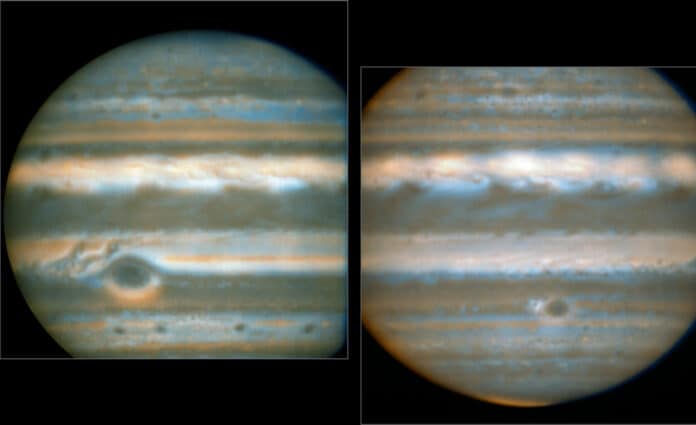Knowledge of the tropospheric temperature field and its fluctuations is crucial to planetary climatology. A dynamical link between tropospheric and stratospheric temperatures, as well as non-seasonal periodic behavior, were suggested by earlier studies of Jupiter. However, these observations either used sparse sampling or were made over shorter periods than Jupiter’s orbit.
New research breaks ground by tracking temperatures in Jupiter’s upper troposphere. The research carried out over four decades by combining data from NASA spacecraft, and ground-based telescope observations discovered surprising patterns in the changes in temperature of Jupiter’s belts and zones.
Like Earth‘s, Jupiter’s troposphere is where clouds develop and storms rage. To comprehend this weather activity, scientists must investigate several characteristics, such as wind, pressure, humidity, and temperature. Since NASA’s Pioneer 10 and 11 missions in the 1970s, scientists have known that Jupiter‘s brighter and whiter bands, known as zones, are places of colder temperatures. In contrast, the planet’s deeper brown-red bands, known as belts, are locations of warmer temperatures.
But there needed to be more data sets to understand how temperatures vary over the long term. Scientists, in this study, studied images of the bright infrared glow (invisible to the human eye) that rises from warmer regions of the atmosphere, directly measuring Jupiter’s temperatures above the colorful clouds. These images were gathered regularly over three of Jupiter’s orbits around the Sun, each lasting 12 Earth years.
They discovered that Jupiter’s temperatures fluctuate over specific time periods that are not linked to the seasons or any other cycles that are now known to science. Scientists weren’t expecting to see temperatures on Jupiter shifting in such predictable cycles because Jupiter has weak seasons and is tilted on its axis by only 3 degrees, compared to Earth’s jaunty 23.5 degrees.
The investigation also uncovered a puzzling link between temperature changes in places distanced thousands of miles: As temperatures went up at specific latitudes in the northern hemisphere, they went down at the same latitudes in the southern hemisphere – like a mirror image across the equator.
NASA noted, “Scientists started this study in 1978. For the duration of their research, they would write proposals several times a year to win observation time on three large telescopes around the world: the Very Large Telescope in Chile as well as NASA’s Infrared Telescope Facility and the Subaru Telescope at the Maunakea Observatories in Hawaii.”
“During the first two decades of the study, scientists took turns traveling to those observatories, gathering the information on temperatures that would eventually allow them to connect the dots. Then came the hard part – combining multiple years’ worth of observations from several telescopes and science instruments to search for patterns. Joining these veteran scientists on their long-duration study were several undergraduate interns, none of whom had been born when the study began.”
Glenn Orton, a senior research scientist at NASA’s Jet Propulsion Laboratory and lead author of the study, said, “We found a connection between how the temperatures varied at very distant latitudes. It’s similar to a phenomenon we see on Earth, where weather and climate patterns in one region can have a noticeable influence on weather elsewhere, with the patterns of variability seemingly ‘teleconnected’ across vast distances through the atmosphere.”
Co-author Leigh Fletcher of the University of Leicester in England said, “We’ve solved one part of the puzzle now: the atmosphere shows these natural cycles. We need to explore both above and below the cloudy layers to understand what’s driving these patterns and why they occur on these particular timescales.”
Scientists hope the study will help them eventually be able to predict weather on Jupiter now that they have a more detailed understanding of it. The research could contribute to climate modeling, with computer simulations of the temperature cycles and how they affect weather – not just for Jupiter, but for all giant planets across our solar system and beyond.
Journal Reference:
- Orton, G.S., Antuñano, A., Fletcher, L.N. et al. Unexpected long-term variability in Jupiter’s tropospheric temperatures. Nat Astron (2022). DOI: 10.1038/s41550-022-01839-0
